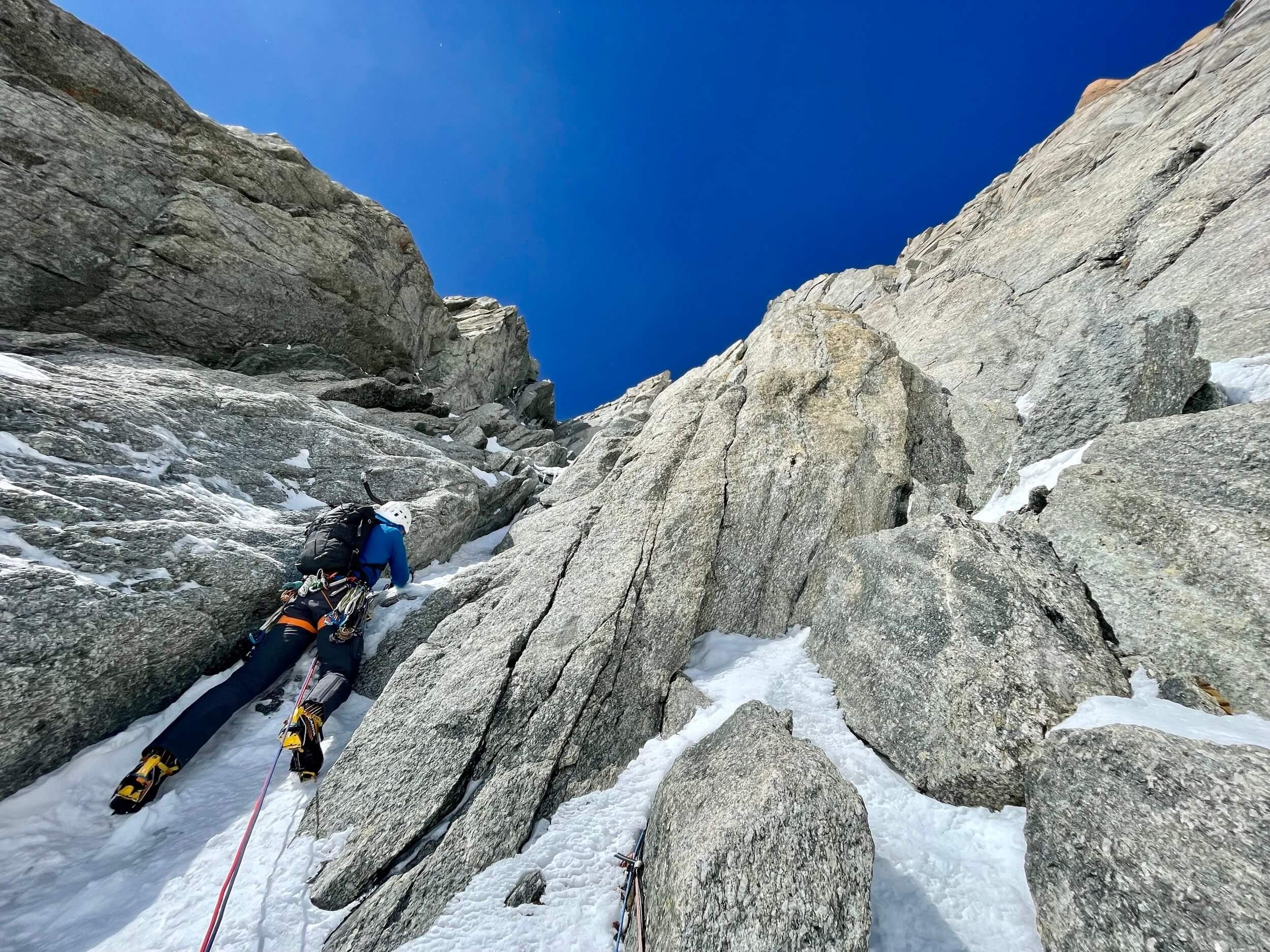
Learn The Fundamentals of Winter Alpine Climbing
The Fundamentals of Winter Alpine Climbing clinic is designed for novice alpinists that want to develop the skills to climb in the big mountains in a winter environment. Our AMGA certified Alpine Guides provide comprehensive and detailed instruction on technical alpine climbing based on a curriculum honed by renowned alpinist and Skyward Mountaineering co-owner, Vince Anderson. Learn the skills necessary to be a self-sufficient alpinist with customized instruction and coaching throughout this 3-day alpine climbing course.
Itinerary
-
We spend this first day covering the basic components of alpine climbing, including:
How to pack for fast and light alpinism
Critical climbing knots
Fundamental crampon techniques
Belaying a climber safely
Of course, we will also do some ice climbing and provide you with focused, actionable feedback on how to best develop your technique. After a full day of learning and climbing, we will gather after dinner for an educational and entertaining presentation of one of your guides’ recent alpine climbing adventures.
-
We delve further into the fundamentals of alpine climbing, including:
The specifics and secrets of effectively using your ice axes
How to read the ice and mentally map your ascent
Rappelling strategies for safe and efficient descents in the mountains
An après-climb relaxation as a team at the Ouray Hot Springs will be well deserved after this long day of climbing.
-
We culminate our learning with a practical application of our skills on a graduation climb of one of Ouray's famous backcountry ice climbs.
December 26 - 28, 2025
February 7 - 9, 2026
No previous climbing experience is required though the Fundamentals of Alpine Clinic is a comprehensive program for a short period of time so some climbing background may be helpful.
Montrose Regional Airport is 45 minutes from Ouray. There is NO rideshare service, you may book a shuttle service or rent a vehicle with AWD/4WD (for winter driving).
There are plentiful hotels in downtown Ouray, conveniently located in walking distance to restaurants and the town hot springs for an aprés-climb relaxation.
Climbers are responsible for providing their own personal clothing and equipment. Skyward Mountaineering may assist in supplying technical equipment with advanced notice. See recommended equipment list below:
-
Underwear: Should be comfortable for a full day of activity, synthetic or merino wool will wick moisture away from the body
Heavyweight socks: Over-the-calf winter weight for superior warmth. Layering two pairs of socks is not recommended as it may impede blood flow and make your toes colder
Warm hat: Should be thin enough to fit under your helmet
Neck gaiter: Optional, lightweight and versatile for adding warmth around ears or covering your face in windy conditions
Softshell climbing gloves: Waterproof with high dexterity. 2 pairs recommended, one midweight and one heavyweight. Guide’s midweight recommendation - Showa Temres 282-02 (size up one from normal)
Mixed climbing gloves: Optional, these highly dexterous gloves have minimal insulation and are best for warmer days, lead climbing or mixed climbing
Midweight top baselayer: Merino wool or synthetic fibers will wick sweat away. Thumb loops are recommended to keep your wrists from being exposed and your hands warmer
Heavyweight bottom baselayer
Midweight fleece jacket: An integrated hood adds warmth and weather protection
Active insulation jacket: Ideal balance of breathability and warmth for winter aerobic activity
Midweight vest: Optional, adds warmth to your core without restricting movement
Softshell jacket: Midweight with a helmet compatible hood. Should have Durable Water Resistance (DWR) coating
Softshell pants: Midweight with reinforced instep. Avoid ski pants as they are often too baggy and likely to catch on your crampons
Insulated parka: Down is lighter/more compressible and a hydrophobic treated down will insulate even when wet. Should have at least 200 grams of 800 fill insulation
-
Climbing backpack: Approximately 35 liters with ice tool attachments
Mountaineering boots: Must be rigid with toe and heel welts for full crampon compatibility
Vertical frontpoint crampons: Dualpoints are better for continuous ice while monopoints are lighter and better suited for mixed climbing
Crampon pouch: Reusing a USPS Tyvek mailing package is a cost effective option, though specific manufactured options exist and are more durable
Technical ice tools: Remove any adze attachment as this may pose an unnecessary hazard for waterfall ice climbing
Climbing helmet: Must be UIAA certified
Harness: Recommended ice clipper compatibility
Tubular belay device with round bar stock locking carabiner
48 inch (120cm) sewn nylon sling: A Personal Anchor System (PAS) may be used instead
1-2 Locking carabiners: Lightweight, screwgate is easier to operate than a triple-action carabiner
1-2 Non locking carabiners: Wiregates are less prone to freezing
2 Ice Clippers
Ice tool tethers: Optional, elastic umbilical style may be used to safeguard against dropping your tools
Trekking pole: A single pole is helpful for balance on slippery/snowy trails
-
Sunglasses: Dimmable recommended, CAT 3 lenses w/ athletic fit
Small tube of sunscreen and SPF chap stick
First aid kit: Small, should include any personal medications
Hand warmers: Optional, for those colder days
Kula cloth: Optional, antimicrobial cloth for people who squat to pee
Pee funnel: Optional, to facilitate easier bathroom usage in a harness for people who squat to pee
Hand warmers: Optional
Fully charged phone
1-2 liters of water: A thermos with your favorite hot drink is recommended. Avoid water bladders and hoses as they are prone to puncture and freezing in a winter environment
High energy lunch and snacks: A healthy mix of fats, sugar, and protein for a full day of the on-the-go (leftover pizza or sandwiches are a great midday pick-me-up)

Includes:
3 days of instructional climbing with an AMGA certified Alpine Guide
Group climbing equipment (ropes, ice/snow/rock protection and anchor material)
Does Not Include:
Additional expenses associated with a change in the itinerary
Travel to/from Ouray
Lodging
Meals
Guide gratuity






